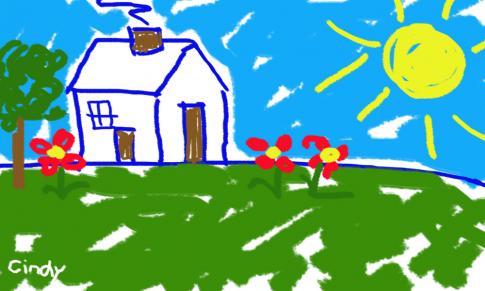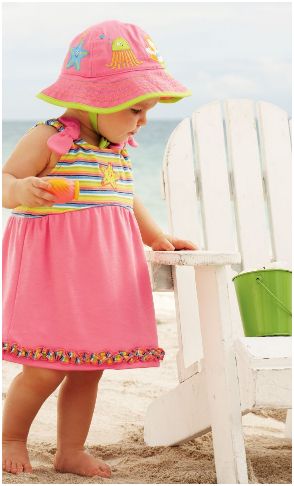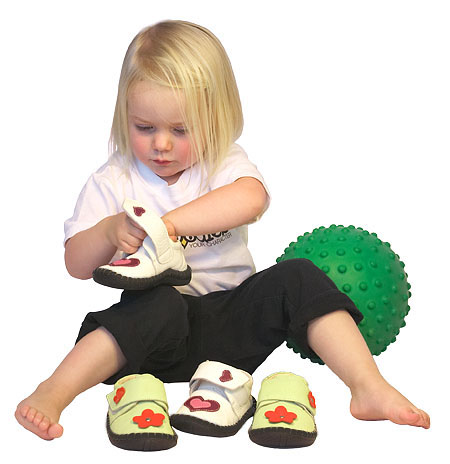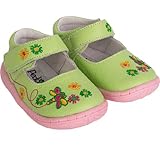Children's Health: Protecting Children From Toxins in the Home

We live in a toxic world. Everyday there is a new article, news segment or book announcing the evils that lurk in our homes, our food, our water, the air, oceans, schools, lawns, playgrounds, everywhere. So, where do we go, what should we eat? Where do our children play, what can they touch and how do they remain safe when even the clothes on their backs are made with toxic chemicals?
I have written about healthy children and food additives to avoid in previous articles. In this hub, I will share simple, easy solutions to help keep children safe in the home. Our children spend most of their day and night at home and unfortunately, the home can be a haven for toxins.
Organic Cleaning is the Nontoxic Avenger
Since many toxins come from outside the home, there are two very simple practices that your family can incorporate that will help prevent the spread of germs and toxins throughout your home.
1- Remove your shoes at the door. Some cultures have done this for generations. There are decorative storage shelves which can be placed near the entrance or a small shelf can be used. The shoes can be put away later. The added benefit with this practice is clean floors for a longer period of time!
2- Wash your hands with soap and warm running water before you do anything else. It does not need to be antibacterial soap (in fact, it's best not to use antibacterial anything). Use clean towels and change them often. Your child should do the same and make sure your little ones coming home from school wash their hands thoroughly! If you pick your children up from school, keep some wet wipes in the car and let them clean their hands when they enter the car. They still need to wash their hands with soap and water when they enter the house.
These two tips alone can prevent many toxins from entering the home. Once it's a habit, you will start to see less illnesses coming home with the kids. These are simple, healthy habits that can be a part of your children's lives.
A Safe, Clean Kitchen is a Necessity
- A sparkling shiny kitchen doesn't mean it's safe if the counters are coated with a thin film of pesticides, disinfectants and antimicrobials.
- Wipe down greasy cabinets and appliances with a solution of 1 tablespoon dish liquid per gallon of water.
- Get rid of sponges and use clean cotton cloths or old cotton t-shirts. Washing a bacteria-infested sponge in the dishwasher redistributes bacteria on the dishes, where they remain alive as long as they stay moist.
"You'd be better off eating a carrot stick that fell in your toilet than one that fell in your sink. Your dog is right."
Charles Gerba
Cleaning Tips
- Vacuum regularly with a real HEPA filter. Carpets have toxic chemicals that can lodge pesticides brought in from outside (refer back to #1). If babies and young children are playing on the carpeted area, it's a good idea to have them sit or lay on a cotton blanket.
- Murphy's Oil Soap can be used to clean floors, finished wood surfaces and non-wood surfaces (including ceramic tile, marble, vinyl, and painted surfaces). It's inexpensive, safe and it cleans. I love the smell and there is no rinsing necessary. I use it on cabinets and doors also. It can be mixed with warm water or it can also be purchased with a pump dispenser which is handy with furniture. It is made with pure vegetable oil and it cleans to a beautiful, natural shine.
- Bon Ami (non-abrasive cleaner) or baking soda can be used to clean sinks, toilets, tubs and drains. The bleach and toxic chemicals used in most bathroom and sink cleaning products are not only dangerous and expensive, but they make their way into our sewage drains flowing into our waterways.
- Use cleaners that are biodegradable, free of aerosol propellants and antibacterial agents. The tub and tile can be cleaned with a white vinegar spray and a scrub brush. Rinse well and dry with a clean cloth. Use bottles with pump dispensers for cleaning.
- Keep an open box of baking soda in the refrigerator and clean the fridge weekly. Trust me, you'll love this practice and your food will be much safer! Check dates and make sure the temperatures are kept at the proper temperatures. Inside the fridge should be kept between 35-40 degrees F. Freezer should be set at 0 or the coldest setting, especially if you have a full freezer.
- Most food poisoning originates in home kitchens and is easily prevented. The Centers for Disease Control (CDC) estimates that each year approximately 76 million Americans are sickened by food poisoning.
- Use living plants for safe air fresheners and for supplying healthy oxygen in the home. Air fresheners contain toxic chemicals such as propane, butane, ethanol, benzene, formaldehyde, acetone and methanol. If inhaled, they can immediately cause soreness in the throat or cause serious respiratory problems, sometimes fatal. (read the labels) Simmering cloves and cinnamon is a safe alternative, or a lemon spritz.
- Avoid using no-pest strips and use nontoxic pest control for pets. The best prevention is a scrupulously clean kitchen with no traces of food left on the counter, the floor or in your pets bowl. Clean the bowl each night. Nontoxic traps can be used or dehydrating powder. Boric acid is mildly toxic yet effective. Make sure it is used out of reach of children and pets. Check with your vet about nontoxic products for your pet, or the very least toxic yet effective.
Clothing and Bedding
I recently read about Disney clothing with the cute vinyl decorations and how they are made with toxic chemicals. How about those really cute favorite character pajamas with the vinyl feet made from synthetic materials? Does your child ever complain about the scratchy label bothering the back of the neck? (No, it's not your neurotic child.) Those labels and very often the final threading of fabrics are made with toxic chemicals. The flame retardant pajamas are toxic.
Synthetic fabrics may contain benzene, ammonia, ethylene, and glycol. Fleece, polyester and polyester blends, permanent press and wrinkle-free fabrics all contain toxic chemicals which are not healthy to have next to your child's skin or in your child's mouth! These chemicals emit toxic and allergic formaldehyde gases. Many babies chew on their clothing, including bibs made from PVC. Use cotton bibs and throw them in the wash. It's better to be safe than sorry.
Toxic-free Organic Clothing

Safe Clothing and Fabric Choices
Babies and young children grow out of clothing quickly. There are stores which sell affordable, comfortable cotton clothing. Often you can find barely used or brand new clothing at garage sales and consignment shops. There is no reason to pay outrageous prices for clothing your child will soon outgrow.
- Always wash new clothes, bedding and towels before use.
- Buy clothing made with natural fibers (cotton, linen, wool, cashmere and silk). Cotton is the most sensible for young children and is breathable.
- If buying organic clothing, be sure to check shrinkage control. Some brands are better than others. Organic cotton is made from cotton which is grown free of pesticides and harsh petroleum based fertilizers with no toxic residues.
- Pedoodles are safe, healthy shoes for babies and toddlers. They are lightweight, flexible and breathable made from natural materials. Soft leather shoes and sandals are a better choice than the cheap plastic and vinyl shoes that are now popular. Your child's feet cannot breathe in synthetic made shoes.
Pedoodle Shoes are Safe and Fun


Safe Bedding Choices
- Use cotton fabrics for bedding sheets and mattress covers. The higher the thread count, the better. A high quality mattress cover made of high-thread-count cotton will help protect the mattress from stains and from allergies caused by dust mites. Cotton flannel and knit cotton t-shirt sheets are also a good choice.
- Sheets should be changed weekly or bi-weekly. Weekly is best with allergies.
- Feather-filled pillows are fine and should be covered with either a high quality cotton pillow cover or a hypoallergenic pillow cover. The New Zealand Medical Journal showed that synthetic pillows contained about seven times more dust mite allergens than feather pillows. Buckwheat hull pillows are also hypoallergenic and do not attract dust mites.
- If possible, keep a window slightly opened to prevent build-up of toxins or keep a houseplant in the bedroom.
- Vacuum and dust with a damp, clean cotton cloth weekly, especially if child has allergies.
Baby beds should include a firm mattress with a waterproof mattress pad (preferably nontoxic made of rubber or wool) and a tightly fitted cotton top sheet. Appropriate, seasonal, breathable sleepwear and your baby is ready for sleep.
Personal Care Products
There are so many products on the shelves marketed for children, and both parents and kids love these cleverly packaged, fragrant products. This doesn't necessarily mean they are the safest choice for your children. In the case of what is considered safe, one must learn the chemicals to avoid.
Many of the most common ingredients in skin and hair products are quite dangerous when absorbed through the skin. Formaldehyde and 1,4-dioxane have been found in popular baby and children's products. Skin Deep Cosmetic Safety Database has a list of recommended products safe for children's skin and still developing bodies. A few precautions and tips follow.
- Use fewer products less frequently. The popular axiom applies here; "less is more".
- Always check ingredients and don't trust claims on labels.
- Try to avoid products with DMDM Hydantoin, fragrance, cetearet and PEG compounds.
- Excellent choices are Aubrey Organics Rosa Mosquetta Rose Hip Seed Oil, Carol's Daughter Hair Oil, Dr. Bronner Castile Liquid Soap- Peppermint (can be used on hair and body), California Baby Shampoo.
There is an extensive list which can be printed out for your convenience. I have it listed in the Additional Information section at the end of this article, Parents Buying Guide. I personally use the Aubrey Organics products and they are fantastic. I believe that if we have information that can empower us as parents and help us make the best choices, we are wise to do whatever we can to protect our children from these harmful chemicals.
Conclusion
There are other categories of which could be written here, including toy safety and pets, indoor air pollution. The Environmental Protection Agency (EPA) ranks indoor air pollution as one of the top five environmental risks to our family's health. If you are a smoker, for the sake of your children, it is best not to smoke indoors or in the car. I cringe when I see an adult smoking with children in the car. I have included links for further information.
I realize there are divergent views on the subject of protecting our children from toxins. While I agree that we don't need to be walking around with masks on, I do believe, with the research studies and information now available of the effects of our toxic world, that we owe our children the safest home environment that we can provide.
Some adults argue that when they were children their parents didn't worry about such precautions and they turned out fine. My response is, are we fine? Look at all of the diseases and disabilities, the cancers that plaque our population. Perhaps if our parents would have had access to what we now know, they would have taken more precautions in the home. (In some respects, some products were less toxic than they are now, like laundry detergent and soap.)
By making simple changes in the way we clean our homes and yards, by purchasing clothing and fabrics made from natural fibers, by carefully choosing personal care products, we are not only helping our children, but also ourselves and our environment and future generations.
Toxic Child: A Wake-Up Story - Please Watch.
References and Additional Information
- Parents Buying Guide: Safety Guide to Children's Personal Care Products
This new children's products safety guide helps parents navigate around bogus claims and find safer products with fewer ingredients linked to allergies, cancer, and other concerns for children. - Protecting the Environment: Children\'s Health | Resources | US EPA
Information on how to protect children from toxins, the sun, lead, and other potential environmental health threats.










